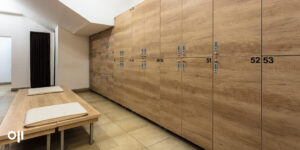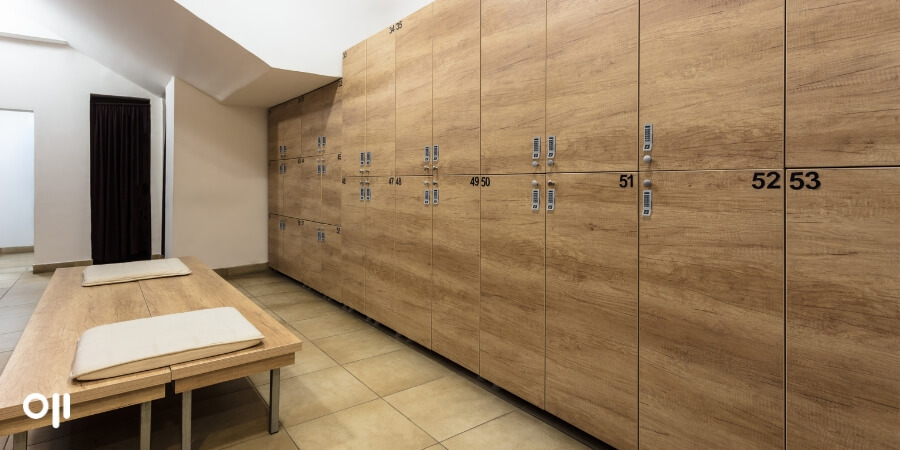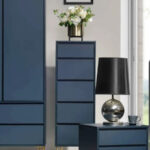
Best Locker locks of 2023
Locker locks are an essential aspect of ensuring the safety and security of personal belongings stored in lockers. Locker locks come in various types, designs, and security levels, depending on the intended use and level of security required. In this article, we will provide a detailed overview of locker locks, including the different types, how they work, and the factors to consider when choosing the right locker lock for your needs.
Types of Locker Locks
- Padlocks: Padlocks are the most common type of locker lock. They are affordable, easy to use, and come in various sizes and shapes. They have a shackle that can be inserted into the lock hasp on the locker door and secured with a key or combination.
- Combination Locks: Combination locks are another popular type of locker lock. They do not require a key, and the lock is opened by dialing in a specific code. Combination locks come in different sizes, and the code can be changed by the user.
- Keyless Locks: Keyless locks are becoming increasingly popular in schools and workplaces. They are opened using a unique code that can be set by the user or an administrator. They are easy to use and eliminate the need for keys.
- Electronic Locks: Electronic locker locks are the most advanced type of locker lock. They use an electronic system to unlock the locker door, and the lock is usually powered by batteries. Electronic locks are commonly used in high-security environments like banks, government buildings, and airports.
How Locker Locks Work
Locker locks work by securing the locker door to prevent unauthorized access. The lock mechanism is attached to the locker door, and the locking mechanism is usually located on the locker hasp or latch. The lock mechanism can be opened using a key or a combination, depending on the type of lock.
Factors to Consider When Choosing Locker Locks
- Security Level: The level of security required should be considered when choosing a locker lock. Higher-security locks like electronic locks and high-security padlocks are suitable for storing valuable items and in high-risk environments.
- Ease of Use: The ease of use is another essential factor to consider. Combination locks and keyless locks are easy to use and eliminate the need for keys, while padlocks require a key to unlock.
- Price: The price of the locker lock is also an important factor to consider. Padlocks and combination locks are relatively affordable, while electronic locks are more expensive.
- Durability: Locker locks should be durable and withstand the wear and tear of daily use. High-quality padlocks and electronic locks are durable and long-lasting.
Features of Locker Locks
Locker locks are a type of security mechanism designed to protect the contents of lockers, cabinets, and other storage units. Here are some of the key features of locker locks:
- Locking mechanism: Locker locks typically feature a locking mechanism that secures the lock in place, preventing unauthorized access to the locker.
- Key or combination: Locker locks can be opened using a key or a combination. Key-operated locks require a physical key to be inserted into the lock to open it, while combination locks require the user to input a specific sequence of numbers or letters to unlock the lock.
- Material: Locker locks can be made from a variety of materials, including metal, plastic, and other durable materials that can withstand wear and tear.
- Size and shape: Locker locks come in a variety of sizes and shapes, designed to fit different types of lockers and storage units.
- Durability: Locker locks must be durable enough to withstand repeated use over time, as well as potential attempts to break or tamper with the lock.
- Ease of use: Locker locks should be easy to operate, whether using a key or combination, to avoid frustration or confusion for the user.
- Security level: Locker locks can have different levels of security, depending on the type of locking mechanism and other features. High-security locker locks may be designed to resist picking, drilling, or other attempts to bypass the lock.
What are the Locker Locks?
Locker locks are specially designed locks used to secure lockers in schools, gyms, workplaces, and other settings. Locker locks are typically small and designed to fit onto a locker’s latch or hasp.
There are many different types of locker locks available, including combination locks, key locks, padlocks, and digital locks. Combination locks are the most common type of locker lock, and they require a sequence of numbers to open. Key locks, on the other hand, use a physical key to unlock the locker. Padlocks are similar to key locks but are designed to be used with a shackle that can be attached to a hasp. Digital locker locks use a keypad or touch screen to enter a code or use biometric authentication to unlock the locker.
Locker locks are an essential component of locker security and help prevent unauthorized access to personal belongings stored in lockers.
How do they Work?
Locker locks work by preventing the latch or hasp of the locker from opening without the correct key, combination, or code. The specific workings of locker locks depend on the type of lock being used.
Combination locks typically have a rotating dial that is used to enter the correct sequence of numbers to open the lock. Once the correct combination is entered, the lock’s internal mechanism is released, and the latch or hasp can be opened.
Key locks use a physical key to unlock the lock. When the key is inserted into the lock, it aligns with the lock’s internal pins or tumblers, allowing the lock to be turned and the latch or hasp to be released.
Padlocks typically work similarly to key locks but use a shackle that can be attached to a hasp or other locking mechanism. The shackle is inserted into the lock body and secured by turning the key.
Digital locker locks use a keypad or touch screen to enter a code or biometric authentication to unlock the locker. The lock’s internal mechanism is released once the correct code or biometric data is entered, allowing the locker to be opened.
Overall, locker locks work by preventing unauthorized access to lockers and ensuring that only the person with the correct key, combination, or code can open the lock and access the locker’s contents.
Locker Locks Installation Process
The installation process for locker locks may vary depending on the type of lock and the type of locker being used. However, here are some general steps that may be followed:
- Gather the necessary tools: The tools required may vary depending on the type of lock and locker being used. Generally, you may need a screwdriver, drill, hammer, and measuring tape.
- Determine the type of lock: Determine the type of lock that you want to install, whether it is a padlock, combination lock, or electronic lock.
- Measure the lock: Measure the lock to determine the size of the hole that needs to be drilled in the locker. The size of the hole may vary depending on the type of lock being used.
- Mark the location: Mark the location where the lock needs to be installed using a pencil or marker. Ensure that the location is at the center of the locker and at a convenient height.
- Drill the hole: Use a drill to drill the hole in the locker. Ensure that the hole is the correct size for the lock.
- Install the lock: Insert the lock into the hole and secure it in place using screws or bolts. Ensure that the lock is properly aligned and tight.
- Test the lock: Test the lock to ensure that it is working properly. Check that the key or combination works and that the lock is secure.
- Label the lock: Label the lock with the locker number or the name of the user to avoid confusion.
Following these steps will help ensure that the locker lock is properly installed and working correctly.
Comparison Between Other Smart Locks and Locker Locks
Smart locks and locker locks serve different purposes, so it’s difficult to make a direct comparison between them. However, here are some key differences between the two types of locks:
- Use Case: Smart locks are primarily used to secure doors in homes, apartments, and other residential or commercial properties. Locker locks, on the other hand, are typically used to secure individual lockers in gyms, schools, and other public spaces.
- Connectivity: Smart locks are connected to the internet and can be controlled remotely through a mobile app, allowing homeowners or property managers to lock and unlock doors from anywhere. Locker locks are usually not connected to the internet and require a physical key or combination to operate.
- Power Source: Smart locks require a power source to operate, either through batteries or wired electrical connections. Locker locks typically use batteries and require less power than smart locks, as they are not connected to the internet.
- Security Features: Smart locks often have more advanced security features than locker locks, such as biometric authentication, video monitoring, and real-time alerts. Locker locks typically have more basic security features, such as a combination or key.
- Installation: Smart locks require more complex installation than locker locks, as they need to be installed on doors and may require electrical wiring. Locker locks can be installed directly onto lockers with minimal installation required.
Overall, while both types of locks provide security, their features and use cases are quite different, making direct comparison difficult. Smart locks are best for securing residential and commercial properties, while locker locks are ideal for securing individual lockers in public spaces.
List of Locker Locks for 2023
Here are some popular locker locks that have been used in the past & present:
- Master Lock 1500iD Speed Dial Combination Lock
- Master Lock 1590D Set Your Own Combination Lock
- ABUS 83/45-300 S2 Schlage Rekeyable Padlock
- Sargent and Greenleaf 8077AD Combination Padlock
- American Lock A700D Solid Steel Padlock
- WordLock PL-003-SL Combination Padlock
- FJM Security SX-575 Combination Padlock
- Brinks 673-70401 Home Security Commercial Discus Lock
- Sesamee K436 4 Dial Bottom Resettable Combination Brass Padlock
- Yale Y150/50/114/1 Brass Body Padlock.
It’s important to note that locker locks may vary in terms of compatibility with specific lockers, so it’s recommended to check with the manufacturer or seller to ensure compatibility before purchasing.
Things to know about Locker Locks
Locker locks are used to secure personal items in various settings, such as schools, gyms, workplaces, and public spaces. Here are some things to know about locker locks:
- Types of locker locks: There are several types of locker locks, including combination locks, key locks, electronic locks, and padlocks. Combination locks are the most common and require a numeric code to open. Key locks require a physical key to unlock, while electronic locks use a digital code or card to open. Padlocks are typically used for outdoor lockers and are secured with a key or combination.
- Security features: Locker locks come with different security features, such as hardened steel shackle, anti-pick mechanisms, and tamper-resistant designs. Look for locks that meet industry standards for security, such as the ANSI/BHMA Grade 2 rating.
- Installation: Locker locks can be installed in different ways, depending on the type of lock and locker. Some locks are built into the locker, while others are external and attached to the locker door. Make sure the lock is installed correctly to ensure maximum security.
- Maintenance: Locker locks require regular maintenance to function properly. This includes cleaning the lock regularly and checking for any damage or wear and tear. It’s also important to change the combination or code periodically to enhance security.
- Accessibility: Locker locks should be easy to use and accessible to everyone. Consider locks with large dials or keypads for users with disabilities or visual impairments.
- Compliance: Some settings, such as schools, may have specific regulations or requirements for locker locks. Make sure to check with the appropriate authorities to ensure compliance with any regulations.
- Price: Locker locks vary in price depending on the type of lock and its features. Consider the level of security required and budget when selecting a locker lock.
Overall, locker locks are an essential component of locker security. By selecting a high-quality lock and following proper maintenance and installation procedures, you can ensure the safety of personal items stored in lockers.
How to choose the best Locker Locks for you
Choosing the best locker lock depends on several factors such as the type of locker you have, the level of security you require, and the convenience of access. Here are some factors to consider when selecting locker locks:
- Locker type: The type of locker you have will determine the type of lock that can be used. Some lockers have built-in locks, while others require external locks.
- Security level: Consider the level of security you require. If you need high-level security, choose locks that are difficult to pick or break, such as combination locks or electronic locks. For lower-level security, padlocks or key locks may suffice.
- Convenience: Consider how easy it is to use the lock. Combination locks and electronic locks can be more convenient since you don’t need a physical key. Key locks can be convenient, but they can be lost or stolen.
- Durability: Choose a lock that is made from durable materials to withstand wear and tear over time.
- Cost: Different types of locker locks come at different price points. Consider your budget and choose a lock that meets your needs while also being affordable.
- Brand reputation: Look for brands with a reputation for quality and reliability. Check reviews and feedback from previous customers to ensure that the lock you choose is dependable.
- Compliance: If you are choosing a locker lock for a specific use case, such as a school locker, make sure that the lock you choose meets any relevant regulations or standards.
By considering these factors, you can choose the best locker lock that suits your needs and provides the right balance of security, convenience, and affordability.
Frequently asked questions about Locker Locks
- What types of locker locks are available?
There are several types of locker locks available, including combination locks, key locks, electronic locks, padlocks, and dial locks.
- What is the difference between a combination lock and a key lock?
A combination lock requires a specific sequence of numbers or letters to unlock, while a key lock requires a physical key to unlock.
- How do I set the combination on my combination lock?
To set the combination on a combination lock, follow the manufacturer’s instructions. Usually, you will need to turn the dial to a specific position, enter the current combination, and then set the new combination.
- Can I change the combination on my lock?
Yes, in most cases, you can change the combination on your lock. Refer to the manufacturer’s instructions for specific details on how to change the combination.
- How do I open a locker lock if I forget the combination?
If you forget the combination to your locker lock, you may be able to reset the combination or use a bypass method. Refer to the manufacturer’s instructions for specific details on how to reset or bypass the lock.
- Can I use the same lock on different lockers?
Yes, in most cases, you can use the same lock on different lockers as long as they are compatible with the type of lock you have.
- Can locker locks be picked?
Yes, locker locks can be picked, but this requires skill and specialized tools. High-security locks are designed to be more resistant to picking.
- How do electronic locker locks work?
Electronic locker locks use electronic components, such as a keypad or card reader, to authenticate the user and unlock the lock. They may also have additional features, such as audit trails or remote management.
- What is the best type of locker lock?
The best type of locker lock depends on your specific needs and preferences. Combination locks and electronic locks are often popular choices for their convenience and security features. High-security padlocks may also be a good option for outdoor or high-risk environments.
Conclusion
Locker locks are an essential aspect of ensuring the safety and security of personal belongings stored in lockers. There are different types of locker locks, including padlocks, combination locks, keyless locks, and electronic locks. The right locker lock for your needs will depend on the intended use and level of security required. When choosing a locker lock, it is important to consider factors like security level, ease of use, price, and durability.



Leave a Reply
Want to join the discussion?Feel free to contribute!